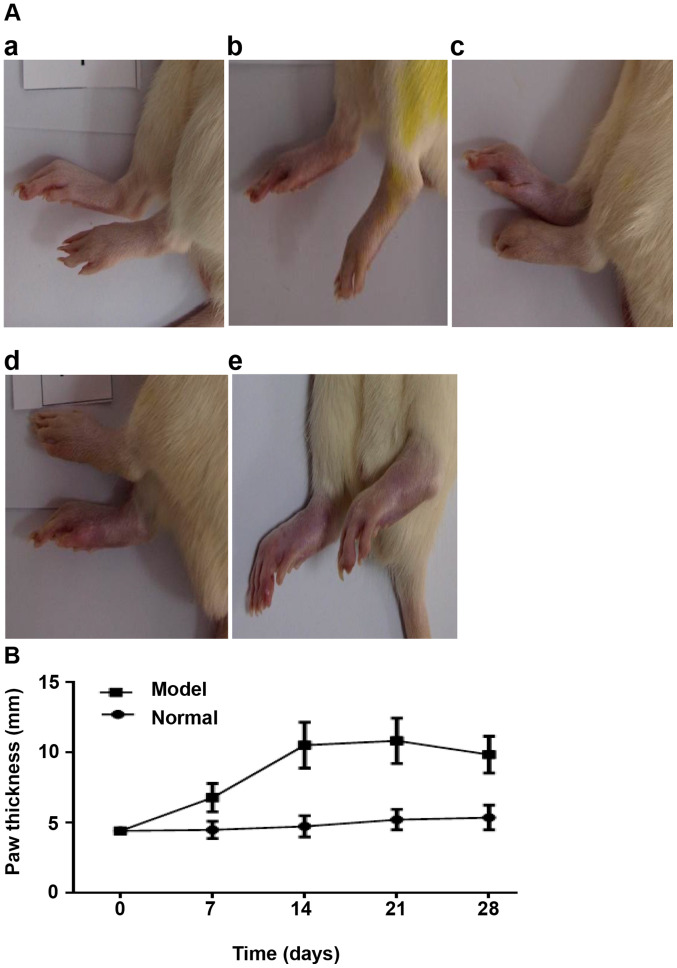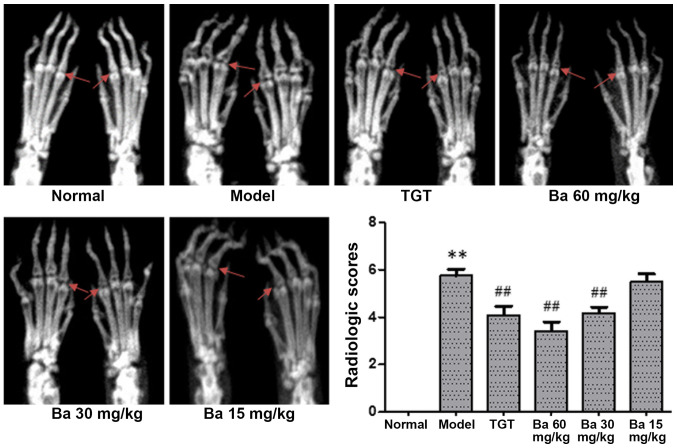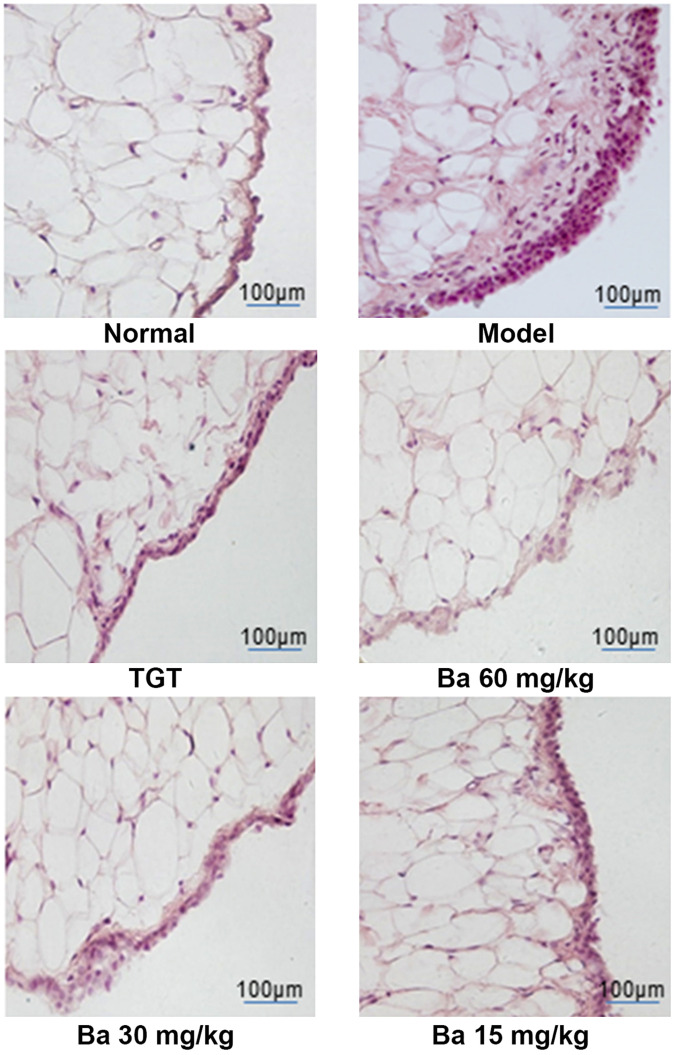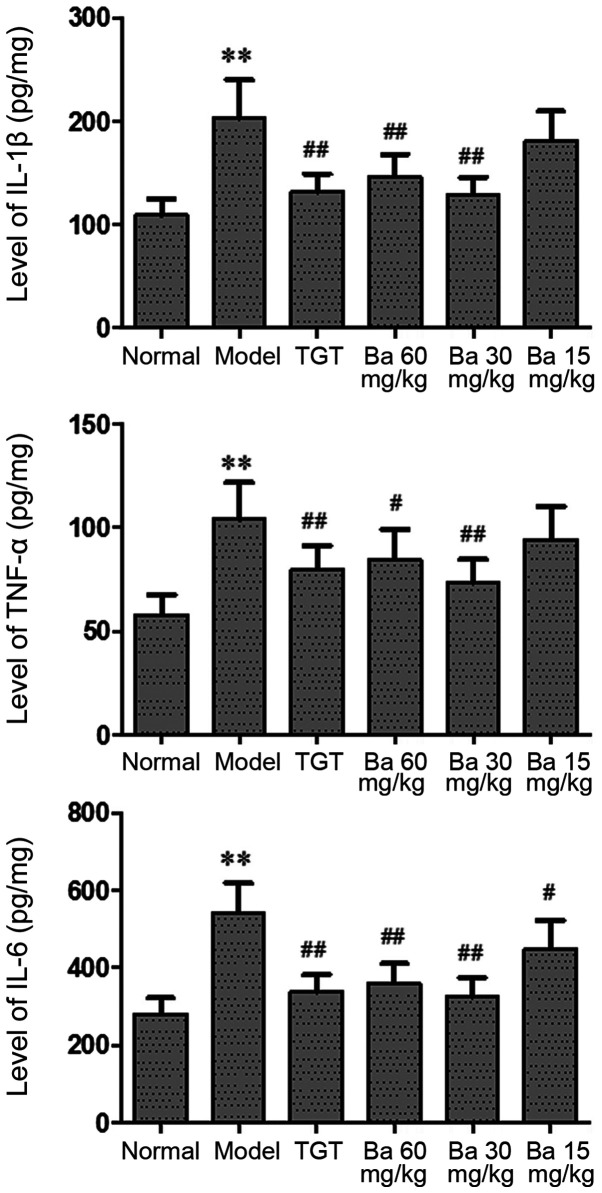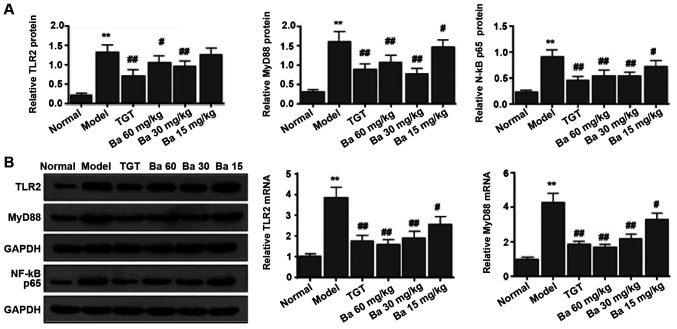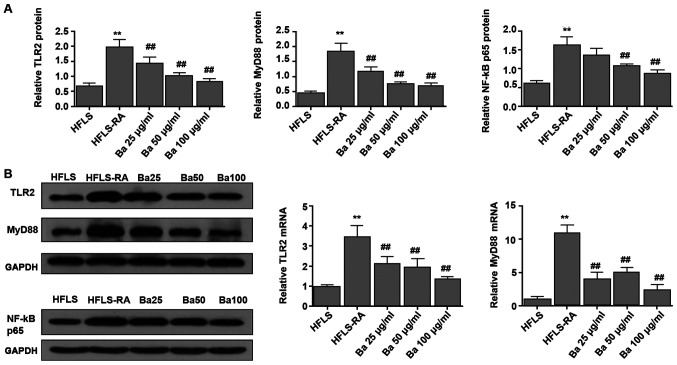Abstract
Baicalin is a flavonoid isolated from the root of Scutellaria baicalensis with anti-inflammatory, antioxidant and antiapoptotic pharmacological properties. However, the therapeutic effect of baicalin on rheumatoid arthritis (RA) is not completely understood. The present study aimed to explore the therapeutic potential and mechanisms underlying baicalin in collagen-induced arthritis (CIA) model rats. CIA was induced in male SD rats. The hind paw thickness and severity of joint injury were monitored to assess the onset of arthritis. At 28 days after the initial immunization, different doses of baicalin were administered once daily via oral gavage for 40 days. The radiologic and pathological alterations were examined using X-ray, and hematoxylin and eosin staining, respectively. ELISA was employed to measure the serum levels of proinflammatory cytokines. Reverse transcription-quantitative PCR and western blotting were conducted to determine the expression of toll-like receptor (TLR)2, myeloid differentiation factor 88 (MYD88) and NF-κB p65. Baicalin treatment noticeably alleviated radiographic and histologic abnormalities in the hind paw joints of CIA model rats in a dose-dependent manner. The serum levels of proinflammatory cytokines were significantly decreased in baicalin-treated CIA model rats compared with vehicle-treated CIA model rats. The mRNA expression levels of TLR2 and MYD88, as well as the protein expression levels of TLR2, MYD88 and NF-κB p65 were significantly decreased by baicalin treatment in the synovial tissue of CIA model rats and human RA fibroblast-like synoviocytes. The results suggested that baicalin may exert a beneficial effect on CIA, which may be mediated by inhibiting the TLR2/MYD88/NF-κB signaling pathway.
Keywords: baicalin, CIA, TLR2, MYD88, NF-κB p65, proinflammatory cytokines
Introduction
Rheumatoid arthritis (RA) is a chronic autoimmune disease characterized by swelling, pain, stiffness and deformity of peripheral joints, which affects 0.5–1% of the adult population worldwide (1). Although a variety of antirheumatic drugs, such as cytokine antagonists, and B cell depletion and T cell co-stimulation blockers, display clinical efficacy for the treatment of RA, the life expectancy in patients with RA is 10–15 years shorter compared with the general population (2). Therefore, developing novel and more potent therapeutic agents for RA is important.
RA is an inflammatory condition that primarily affects the small synovial joints of the hands and feet (3). The main pathological features of RA include synovial hyperplasia and the secretion of proinflammatory cytokines, such as tumor necrosis factor-α (TNF-α), interleukin (IL)-1, IL-6 and IL-8, in the affected joints (4,5). Activated fibroblast-like synoviocytes (FLSs) serve a central role in RA pathogenesis by producing inflammatory cytokines, chemokines and proteinases that degrade the extracellular matrix (4,6). A number of proinflammatory cytokines, such as TNF-α, IL-1 and IL-6, are involved in the pathogenesis of RA, serving as therapeutic targets for the development of novel drugs against RA (7).
Toll-like receptors (TLRs), a family of type I transmembrane glycoproteins, have been implicated in the inflammatory and immune responses in RA. When exposed to an immunogenic stimulus, cells within the joint display increased TLR expression and increased expression of the corresponding ligands, such as bacterial peptidoglycan and heat shock protein 60 (8), which triggers rapid expression of proinflammatory cytokines and chemokines that orchestrate immune responses, leading to inflammation and damage to the joints in patients with RA (9). Previous studies have highlighted the importance of TLR2 in RA via in vitro systems and animal models (10,11). Highly expressed TLR2 in RA synovial tissue-lining macrophages and fibroblasts heterodimerizes with TLR1 or TLR6 upon ligand binding and interacts with myeloid differentiation factor 88 (MYD88) to initiate a signaling cascade that results in activation of key transcription factors, including NF-κB (12). Previous studies have demonstrated that TLR2 ligation in RA FLSs enhances proinflammatory cytokine secretion (13), and TLR2 blockade significantly inhibits cytokine secretion (14), indicating an indispensable role of TLR2 signaling in RA development. Therefore, targeting TLR2 and the downstream signaling pathways may serve as a potential therapeutic approach in RA treatment.
Baicalin (7-glucuronic acid, 5,6-dihydroxyflavone) is a flavonoid compound isolated from the root of Scutellaria baicalensis (15), which possesses multiple pharmacological effects, including anti-inflammatory, antioxidative, antiapoptotic and immune regulatory properties (16–18). Previous studies have suggested that baicalin could ameliorate CIA in animal models (19,20). In addition, baicalin can attenuate periodontitis and lipopolysaccharide (LPS)-induced fever in rat models via inhibition of the TLR2 or TLR4/MYD88/p38 mitogen activated protein kinase (MAPK)-NF-κB signaling pathways (21,22). However, whether TLR2 signaling is associated with the beneficial role of baicalin in CIA is not completely understood.
In the present study, a CIA rat model that is widely used to mimic the joint inflammation observed in human RA (23) was established to evaluate the potential therapeutic effect of baicalin in CIA. Alterations to the serum levels of proinflammatory cytokines and the expression of TLR2, MYD88 and NF-κB p65 in response to baicalin treatment were examined to investigate the mechanisms underlying the therapeutic effects of baicalin in CIA. The present study indicated that baicalin may serve as a promising therapeutic agent to target the inflammatory response and TLR2/MYD88/NF-κB signaling in RA.
Materials and methods
Animals and CIA modeling
A total of 100 male Sprague-Dawley (SD) rats (age, 8 weeks; weight, 180±20 g) were obtained from the Experimental Animal Center of Ningxia Medical University (certificate no. SCXK 2015-0001). The rats were fed and housed in a standard pathogen-free environment with a temperature of 22±2°C, 55±5% humidity, 12-h light/dark cycles and free access to food and water. All animal care and procedures described in the present study were approved by the Ethics Committee of Ningxia Medical University (approval no. 2015-125). All animal experiments were performed in accordance with the Guidelines for the Care and Use of Animals published by the P.R. China Ministry of Health (January 1998) (24). The CIA model was established in 84 rats as previously described (13,14). The normal group consisted of the remaining 16 rats. Briefly, 0.1 ml bovine collagen II (Sigma-Aldrich; Merck KGaA) emulsified in complete Freund's adjuvant (Sigma-Aldrich; Merck KGaA) was administered twice at 7-day intervals by intra-dermal injection into the back, base of tail and the footpad of each rat. At 14 days after the initial immunization, each rat was administered with a booster subcutaneous injection at the base of tail. After the booster injection, the degree of joint redness and swelling were evaluated using a 5-grade arthritis scoring method, as previously described (15,16). The paw thickness (mm) of each rat was measured with a Vernier caliper every 7 days during the establishment of the CIA rat model (28 days). At 28 days after the initial immunization, 80 rats with an arthritis score of ≥2 were selected as CIA model rats.
Baicalin treatment
At 28 days after the initial immunization, the CIA model rats were randomly divided into five groups (n=16 rats/group): i) Model; ii) Tripterygium Glycosides Tablet (TGT; Yuanda Pharmaceutical Huangshi Feiyun Pharmaceutical Co., Ltd.; 10 mg/kg/day); iii) 15 mg/kg/day baicalin (purity 98%; Nanjing Chunqiu Biological Engineering Co., Ltd.); (iv) 30 mg/kg/day baicalin; and v) 60 mg/kg/day baicalin. The doses of baicalin used in the present study were determined based on a previous study (1). TGT was dissolved in normal saline and baicalin was dissolved in saline (pH 8.0). Rats were administered once a day with TGT or baicalin by oral gavage. Rats in the normal and model groups were administered once a day with an equivalent volume of saline by oral gavage. After 40 days of treatment, the rats were fasted for 8 h (with free access to water) and then anaesthetized with 10% chloral hydrate (300 mg/kg) via intraperitoneal injection. Blood (~5 ml) was obtained from the retro-orbital plexus and maintained at room temperature for 2 h. Serum was collected by centrifugation at 2,000 × g, 4°300*12C for 15 min and stored at −80°C until further use. Subsequently, the rats were sacrificed by cervical dislocation. No signs of peritonitis were observed prior to sacrifice. The synovium was immediately isolated from the hind knee joint, washed with sterile normal saline and stored at −80°C.
Cell culture and treatment
Normal human fibroblast-like synoviocytes (HFLS; cat. no. 338586; BeNa Culture Collection) and RA human fibroblast-like synoviocytes (HFLS-RA; cat. no. 337864; BeNa Culture Collection) were maintained in synoviocyte growth medium (Gibco; Thermo Fisher Scientific, Inc.) supplemented with 100 IU/ml penicillin and 100 mg/ml streptomycin at 37°C in a humidified atmosphere of 5% CO2. Passage 4–7 cells were used for subsequent in vitro experiments. HFLS-RAs were serum-starved for 12 h at 37°C prior to baicalin treatment (25, 50 or 100 µg/ml) for 48 h at 37°C. Untreated HFLSs were used as controls.
Radiographic assessment
Following sacrifice, the rat hind paws were subjected to X-ray scans to observe the radiologic alterations using a MRAD-D50S RADREX–I system (Toshiba Medical Manufacturing Co., Ltd.) with the following parameters: 40 kV, 100 mA and 0.02 millisecond. Images were read and scored by a blinded independent radiologist as previously described (25): 0, no radiologic alterations; 1, mild alterations with tissue swelling and edema; 2, moderate alterations with joint erosion and disfiguration; 3, severe alterations with bone erosion and osteophyte formation. The radiologic score for each rat was expressed as the sum of the results of both hind paws.
Hematoxylin and eosin (H&E) staining
Rat synovium was fixed using 4% paraformaldehyde for 48 h at room temperature, dehydrated using a graded alcohol series, cleared with xylene and embedded in paraffin at room temperature. Tissues were cut into 5-µm thick paraffin sections using a tissue microtome. The deparaffinized tissue sections were stained with H&E for 10 min at room temperature. Synovial hyperplasia was observed in three randomly selected fields of view using a CKX41SF inverted microscope (Olympus Corporation; magnification, ×200).
ELISA
Serum levels of IL-1β, TNF-α and IL-6 were determined using ELISA kits (Dakewe Biotech, Ltd.; cat. nos. DKW12-3720, DKW12-3012 and DKW12-3060, respectively) according to the manufacturer's instructions.
Reverse transcription-quantitative PCR (RT-qPCR)
Total RNA was isolated from rat synovial tissues or in vitro cultured human cells using TRIzol® (Invitrogen) according to the manufacturer's instructions. Total RNA was reverse transcribed into cDNA at 42°C for 60 min, then 70°C for 10 min using M-MLV reverse transcription kit (Promega Corporation), according to the manufacturer's protocol. RT-qPCR was performed using a 20 µl volume containing 1.5 µl cDNA, 0.5 µl forward primer (10 pmol/µl), 0.5 µl reverse primer (10 pmol/µl), 10 µl SYBR-Green mix (Bio-Rad Laboratories, Inc.) and 7.5 µl deionized distilled H2O. The sequences of the primers (Sangon Biotech Co., Ltd.) used for qPCR are listed in Tables I and II. The following thermocycling conditions were used for qPCR: Initial denaturation at 94°C for 15 min; followed by 40 cycles of denaturation at 94°C for 15 sec, annealing at 60°C for 34 sec, and extension at 72°C for 15 sec; and final extension at 72°C for 10 min. mRNA expression levels were quantified using the 2−ΔΔCq method (26) and normalized to the internal reference gene GAPDH.
Table I.
Primer sequences used to detect gene expression in rat synovial tissue by reverse transcription-quantitative PCR.
| Gene | Sequence (5′-3′) |
|---|---|
| TLR2 | F: GACTCTGGAAGCAGGTGACA |
| R: CAGTCAACCAGGACATGGAC | |
| MYD88 | F: TGGTGGTTGTTTCTGACGAT |
| R: GATCAGTCGCTTCTGTTGGA | |
| GAPDH | F: CAACTCCCTCAAGATTGTCAGCAA |
| R: GGCATGGACTGTGGTCATGA |
TLR2, toll-like receptor 2; MYD88, myeloid differentiation factor 88; F, forward; R, reverse.
Table II.
Primer sequences used to detect gene expression in human fibroblast-like synoviocytes by reverse transcription-quantitative PCR.
| Gene | Sequence (5′-3′) |
|---|---|
| TLR2 | F: AAGCACTGGCCAAAGTCTTG |
| R: TGTCCTGTGACATTCCGACA | |
| MYD88 | F: CCTGCAGAGCAAGGAATGTG |
| R: GTCGCAGACAGTGATGAACC | |
| GAPDH | F: GGGTGTGAACCATGAGAAGT |
| R: GACTGTGGTCATGAGTCCT |
TLR2, toll-like receptor 2; MYD88, myeloid differentiation factor 88; F, forward; R, reverse.
Western blotting
Total protein was extracted from rat synovial tissues or in vitro cultured human cells in pre-cooled cell lysis solution (Beijing Solarbio Science & Technology Co., Ltd.) containing protease and phosphatase inhibitors to inhibit protein degradation (Beijing Solarbio Science & Technology Co., Ltd.). Total protein was quantified using a bicinchoninic acid protein assay method. Proteins were separated by 10% SDS-PAGE and transferred to PVDF membranes. The membranes were blocked with 5% skim milk diluted by 2% PBS for 60 min at room temperature and then incubated overnight at 4°C with the following primary antibodies: Anti-TLR2 (Santa Cruz Biotechnology, Inc.; cat. no.sc-10739; 1:1,000), anti-MYD88 (Abcam; cat. no. ab2064; 1:2,000), anti-NF-κB p65 (CST Biological Reagents Co., Ltd.; cat. no.4764; 1:3,000) and anti-GAPDH (Abcam; cat. no. ab8245; 1:500). The membranes were washed with TBS containing 0.1% Tween™ 20 and incubated with horseradish peroxidase-conjugated secondary antibodies (OriGene Technologies, Inc.; cat. no. ZB-2301; 1:1,000 for TLR2; 1:2,000 for MYD88; 1:2,000 for NF-κB p65; 1:10,000 for GAPDH) at 37°C for 60 min. After washing with TBS three times, protein bands were visualized using electrochemiluminescence reagent (Santa Cruz Biotechnology, Inc.). Protein expression levels were quantified using Image-Pro Plus software (version 6.0; Media Cybernetics, Inc.) with GAPDH as the loading control.
Statistical analysis
Data are expressed as the mean ± standard deviation of three experiments (n=6 rats in each group). Statistical analyses were conducted using SPSS software (version 17.0; SPSS, Inc.). Comparisons among multiple groups were analyzed using one-way ANOVA followed by Tukey's post hoc test. P<0.05 was considered to indicate a statistically significant difference.
Results
Baicalin treatment alleviates collagen-induced joint injury in rats
To investigate the potential therapeutic effects of baicalin on RA, a CIA rat model that is widely used to mimic the joint inflammation observed in patients with RA was established (23). The onset of arthritis in the model group occurred at day 7 following primary collagen immunization, as evidenced by a notable increase in hind paw thickness from day 7 to day 28 (Fig. 1B) and clinical manifestations, such as functional impairment and swollen red paws, compared with the normal group (Fig. 1A). No joint destruction was observed in the normal group, whereas notable bone erosion was observed in the model group (Fig. 2). Compared with the model group, the radiographic change in the 15 mg/kg baicalin group was minimal. Moreover, moderate alterations were observed in rats treated with TGT or 30 mg/kg baicalin, whereas obvious alleviation was observed in the joints of rats treated with 60 mg/kg baicalin compared with the model group (Fig. 2). Consistently, the mean radiologic scores of rats receiving TGT, 30 mg/kg baicalin and 60 mg/kg baicalin were significantly lower compared with the model group (P<0.01; Fig. 2), suggesting that both TGT and baicalin could alleviate collagen-induced bone erosion and destruction of the joints. CIA model rats receiving 60 mg/kg baicalin exhibited the most potent protection, as indicated by the lowest radiologic score recorded among the five different groups (Fig. 2).
Figure 1.
Paw thickness and assessment of arthritis in CIA model rats. (A) 5-grade arthritis scoring method. (A-a) 0, normal without any signs of arthritis; (A-b) 1, mild redness and swelling of the toe joints; (A-c) 2, moderate redness and swelling of the toe joints; (A-d) 3, severe redness and swelling of the ankle; and (A-e) 4, extreme severe redness, swelling and deformation of the ankle joints. (B) The paw thickness (mm) of each rat was measured with a Vernier caliper every 7 days during the establishment of the CIA rat model. Paw thickness is expressed as the sum of the results of both hind paws. CIA, collagen-induced arthritis.
Figure 2.
Therapeutic effects of baicalin on joint destruction in collagen-induced arthritis model rats. After 40 days of treatment, the rats were sacrificed. In each group, six rats were randomly selected and their hind limbs were subjected to radiographic assessment using the following scoring method: 0, no radiologic alterations; 1, mild alterations with tissue swelling and edema; 2, moderate alterations with joint erosion and disfiguration; 3, severe alterations with bone erosion and osteophyte formation. As indicate by the red arrows, no joint destruction was observed in the normal group, whereas notable bone erosion was observed in the model group. **P<0.01 vs. normal; ##P<0.01 vs. model. TGT, tripterygium glycosides tablet; Ba, baicalin.
Subsequently, histologic analysis of synovial tissue from the knee joint after 40 days of treatment was performed to further evaluate the therapeutic effect of baicalin. H&E staining indicated that the normal group exhibited a normal synovium appearance, whereas the model group demonstrated notable histological abnormalities, including synovial thickening, inflammatory cell infiltration and excessive proliferation of synovial fibroblasts. Compared with the model group, baicalin-treated rats displayed a dose-dependent improvement to histological changes, further indicating the beneficial effect of baicalin on collagen-induced joint injury (Fig. 3).
Figure 3.
Effect of baicalin on pathological alterations in the knee joint synovium of CIA model rats. Hematoxylin and eosin staining was performed to assess the pathological alterations in the synovial tissue of knees of CIA model rats. Pathological alterations were evaluated based on inflammatory cell infiltration and large synovial fibroblast proliferation. CIA, collagen-induced arthritis; TGT, tripterygium glycosides tablet; Ba, baicalin.
Baicalin inhibits the production of IL-1β, TNF-α and IL-6
RA is a chronic inflammatory disease (6); therefore, whether baicalin could modulate the inflammatory process in CIA model rats was investigated. The serum levels of proinflammatory cytokines, including IL-1β, TNF-α and IL-6, were significantly increased in the model group compared with the normal group (P<0.01), whereas the serum levels of proinflammatory cytokines were significantly decreased in the TGT (P<0.01), 30 mg/kg baicalin (P<0.01) and 60 mg/kg baicalin (P<0.05 for TNF-α; P<0.01 for IL-1β and IL-6) groups compared with the model group, suggesting an anti-inflammatory role of baicalin in CIA model rats (Fig. 4).
Figure 4.
Serum levels of proinflammatory cytokines. After 40 days of treatment, serum levels of IL-1β, TNF-α and IL-6 were determined via ELISA. **P<0.01 vs. normal; #P<0.05 and ##P<0.01 vs. model. IL, interleukin; TNF-α, tumor necrosis factor-α; TGT, tripterygium glycosides tablet; Ba, baicalin.
Baicalin suppresses the TLR2/MYD88/NF-κB signaling pathway in the synovial tissue of rats
To further investigate the mechanism underlying the anti-inflammatory effect of baicalin in CIA model rats, the expression levels of TLR2, MYD88 and NF-κB p65 in the synovial tissue from the knee joint of rats were measured, as TLR signaling is extensively involved in the inflammatory response in human RA (27). Compared with the model group, treatment with different doses of baicalin significantly attenuated CIA-induced mRNA and protein expression of TLR2 and MYD88; however, TLR2 protein expression levels were not significantly decreased by 15 mg/kg baicalin compared with the model group. Similar results were observed for the protein expression levels of NF-κB (Fig. 5). The results suggested an involvement of the TLR2/MYD88/NF-κB signaling pathway in the development of CIA in rats.
Figure 5.
TLR2, MYD88 and NF-κB p65 expression in the knee joint synovium of collagen-induced arthritis model rats. After 40 days of treatment, the (A) protein expression levels of TLR2, MYD88 and NF-κB p65, and (B) mRNA expression levels of TLR2 and MYD88 were measured. **P<0.01 vs. normal; #P<0.05 and ##P<0.01 vs. model. TLR2, toll-like receptor 2; MYD88, myeloid differentiation factor 88; TGT, tripterygium glycosides tablet; Ba, baicalin.
Baicalin suppresses the TLR2/MYD88/NF-κB signaling pathway in cultured HFLSs
Subsequently, the expression levels of TLR2, MyD88 and NF-κB p65 in cultured HFLSs were measured. Compared with untreated HFLS-RA cells, the mRNA expression levels of TLR2 and MYD88, as well as the protein expression levels of TLR2, MYD88 and NF-κB p65 were significantly decreased in baicalin-treated HFLS-RA cells. However, compared with untreated HFLA-RAs, the protein expression level of NF-κB p65 was not significantly decreased by 25 mg/kg baicalin (Fig. 6). The results were consistent with the results observed in CIA model rats, further indicating the involvement of the TLR2/MYD88/NF-κB signaling pathway in synovial inflammation.
Figure 6.
TLR2, MYD88 and NF-κB p65 expression in HFLSs and HFLS-RAs. The (A) protein expression levels of TLR2, MYD88 and NF-κB p65, and (B) mRNA expressions of TLR2 and MYD88 were measured. Compared with untreated HFLS-RA cells, the mRNA expression levels of TLR2 and MYD88, as well as the protein expression levels of TLR2, MYD88 and NF-κB p65 were significantly decreased in baicalin-treated HFLS-RA cells. **P<0.01 vs. HFLS; ##P<0.01 vs. HFLS-RA. TLR2, toll-like receptor 2; MYD88, myeloid differentiation factor 88; HFLS, human fibroblast-like synoviocyte; HFLS-RA, human fibroblast-like synoviocyte-rheumatoid arthritis; TGT, tripterygium glycosides tablet; Ba, baicalin.
Discussion
The CIA model is the most widely used animal model for RA studies due to the similar pathological and arthritic presentations between CIA model animals and patients with RA (23). In the present study, CIA was induced in male SD rats, and a notable increase in hind paw thickness was observed in the model group compared with the normal group from day 7 post-primary collagen immunization. In the later stages of CIA model induction, acute inflammation gradually alleviated, leading to the redness and swelling of hind paws gradually subsiding. As chronic inflammation continued, CIA model rats displayed clinical manifestations, such as functional impairment and notable histological abnormalities in the synovial tissue, such as synovial thickening and inflammatory cell infiltration. The results indicated that the CIA model was successfully established in the present study. The results also indicated that baicalin dose-dependently alleviated joint injury in CIA model rats. Furthermore, to the best of our knowledge, the present study demonstrated for the first time that baicalin could suppress the TLR2/MYD88/NF-κB signaling pathway in the synovial tissue of CIA model rats as well as in HFLS-RAs in vitro, suggesting that blockade of TLR2/MYD88/NF-κB signaling may be associated with the beneficial role of baicalin in CIA model rats.
The pathogenic mechanism underlying RA is complex, with genetic, environmental and immunological factors contributing to RA incidence and development (28,29). Increasing evidence indicates that various immune cells and cytokines are involved in the pathogenesis of RA (30). The present study indicated that there was a notable increase in the number of inflammatory cells and a significant increase in serum levels of IL-1β, TNF-α and IL-6 in the synovial tissue were observed in CIA model rats compared with normal rats, which was consistent with previous studies (31,32). It has been reported that baicalin exerts anti-inflammatory effects in various disorders. For example, baicalin inhibits LPS-induced inflammation caused by endotoxic shock (21). Baicalin administration also inhibits inflammatory cell infiltration and expression of proinflammatory cytokines in an animal model of multiple sclerosis (33). Similar results were observed in the present study, highlighting the potential of baicalin as an anti-inflammatory therapeutic agent in RA.
The TLR2/MYD88/NF-κB signaling pathway serves an essential role in RA development by enhancing the secretion of proinflammatory cytokines and matrix metallopeptidases (10–14). The present study indicated that the mRNA and protein expression levels of TLR2, MYD88 and NF-κB p65 in synovial tissue, as well as the systemic levels of IL-1β, TNF-α and IL-6 were significantly increased in CIA model rats compared with normal rats. Previous studies demonstrated that baicalin inhibits the TLR2 or TLR4/MYD88/p38 MAPK/NF-κB signaling pathways in periodontitis and LPS-induced fever in rats (21,22). In addition, suppression of synovial NF-κB p65 expression is involved in baicalin-relieved joint inflammation in CIA model rats (20). In the present study, following treatment with different doses of baicalin, the amelioration of synovial lesions was accompanied by significant suppression of the TLR2/MYD88/NF-κB p65 signaling pathway, suggesting that the beneficial effect of baicalin on CIA may be mediated via inhibiting activation of the TLR2/MYD88/NF-κB signaling pathway in the synovial tissue of CIA model rats.
Collectively, the results of the present study suggested that baicalin exerted an anti-inflammatory effect on CIA model rats, and may serve as a potential therapeutic agent in RA. The inhibitory role of baicalin in collagen-induced inflammatory responses may be mediated by suppression of the TLR2/MYD88/NF-κB p65 signaling pathway.
The present study had two main limitations. Firstly, a large number of rats were used and secondly, TGT treatment was not used in the in vitro experiments because sterile TGT solution was not available. The TGT tables used for the in vitro experiments contain starch that can easily block the mesh of the filter during the filtration and degerming process.
Acknowledgements
Not applicable.
Glossary
Abbreviations
- RA
rheumatoid arthritis
- CIA
collagen-induced arthritis
- TNF-α
tumor necrosis factor-α
- IL-1
interleukin-1
- TLRs
toll-like receptors
- MYD88
myeloid differentiation factor 88
- LPS
lipopolysaccharide
- SD
Sprague-Dawley
- HFLS
human fibroblast-like synoviocytes
- RT-qPCR
reverse transcription-quantitative PCR
Funding
The present study was supported by The National Natural Science Foundation of China (grant no. 81560724) and West China Top Class Discipline Project in Basic Medical Sciences, Ningxia Medical University (grant no. NXYLXK2017B07).
Availability of data and materials
The datasets used and/or analyzed during the current study are available from the corresponding author on reasonable request.
Authors' contributions
QW and RM designed the study. LB, YB, YY, WZ, LH, LW and HD performed the experiments. LB, WZ and LH contributed reagents or analytical tools. LB and YB analyzed the data. QW, LB and YB drafted the manuscript. All authors read and approved the final manuscript.
Ethics approval and consent to participate
The present study was approved by the Ethics Committee of Ningxia Medical University (approval no. 2015-125). All animal experiments were performed in accordance with the Guidelines for the Care and Use of Animals published by the P.R. China Ministry of Health (January 25, 1998).
Patient consent for publication
Not applicable.
Competing interests
The authors declare that they have no competing interests.
References
- 1.Mclnnes IB, Schett G. The pathogenesis of rheumatoid arthritis. N Engl J Med. 2011;365:2833–2219. doi: 10.1056/NEJMra1004965. [DOI] [PubMed] [Google Scholar]
- 2.van den Hoek J, Boshuizen HC, Roorda LD, Tijhuis GJ, Nurmohamed MT, van den Bos GA, Dekker J. Mortality in patients with rheumatoid arthritis: A 15-year prospective cohort study. Rheumatol Int. 2017;37:487–493. doi: 10.1007/s00296-016-3638-5. [DOI] [PMC free article] [PubMed] [Google Scholar]
- 3.Bartok B, Firestein GS. Fibroblast-like synoviocytes: Key effector cells in rheumatoid arthritis. Immunol Rev. 2010;233:233–255. doi: 10.1111/j.0105-2896.2009.00859.x. [DOI] [PMC free article] [PubMed] [Google Scholar]
- 4.Guo Q, Wang Y, Xu D, Nossent J, Pavlos NJ, Xu J. Rheumatoid arthritis: Pathological mechanisms and modern pharmacologic therapies. Bone Res. 2018;6:15. doi: 10.1038/s41413-018-0016-9. [DOI] [PMC free article] [PubMed] [Google Scholar]
- 5.Branimir A, Miroslav M. Pathogenesis of rheumatoid arthritis. Reumatizam. 2014;61:19–23. (In Croatian) [PubMed] [Google Scholar]
- 6.Araki Y, Mimura T. The Mechanisms underlying chronic inflammation in rheumatoid arthritis from the perspective of the epigenetic landscape. J Immunol Res. 2016;2016:6290682. doi: 10.1155/2016/6290682. [DOI] [PMC free article] [PubMed] [Google Scholar]
- 7.Wilsdon TD, Hill CL. Managing the drug treatment of rheumatoid arthritis. Aust Prescr. 2017;40:51–58. doi: 10.18773/austprescr.2017.012. [DOI] [PMC free article] [PubMed] [Google Scholar]
- 8.Akira S, Uematsu S, Takeuchi O. Pathogen recognition and innate immunity. Cell. 2006;124:783–801. doi: 10.1016/j.cell.2006.02.015. [DOI] [PubMed] [Google Scholar]
- 9.Huang QQ, Pope RM. The role of toll-like receptors in rheumatoid arthritis. Curr Rheumatol Rep. 2009;11:357–364. doi: 10.1007/s11926-009-0051-z. [DOI] [PMC free article] [PubMed] [Google Scholar]
- 10.Jimenez-Dalmaroni MJ, Gerswhin ME, Adamopoulos IE. The critical role of toll-like receptors-from microbial recognition to autoimmunity: A comprehensive review. Autoimmun Rev. 2016;15:1–8. doi: 10.1016/j.autrev.2015.08.009. [DOI] [PMC free article] [PubMed] [Google Scholar]
- 11.Huang QQ, Pope RM. The role of glycoprotein 96 in the persistent inflammation of rheumatoid arthritis. Arch Biochem Biophys. 2013;530:1–6. doi: 10.1016/j.abb.2012.12.008. [DOI] [PMC free article] [PubMed] [Google Scholar]
- 12.Sampaio NG, Kocan M, Schofield L, Pfleger KDG, Eriksson EM. Investigation of interactions between TLR2, MyD88 and TIRAP by bioluminescence resonance energy transfer is hampered by artefacts of protein overexpression. PLoS One. 2018;13:e0202408. doi: 10.1371/journal.pone.0202408. [DOI] [PMC free article] [PubMed] [Google Scholar]
- 13.Iwahashi M, Yamamura M, Aita T, Okamoto A, Ueno A, Ogawa N, Akashi S, Miyake K, Godowski PJ, Makino H. Expression of Toll-like receptor 2 on CD16+ blood monocytes and synovial tissue macrophages in rheumatoid arthritis. Arthritis Rheum. 2004;50:1457–1467. doi: 10.1002/art.20219. [DOI] [PubMed] [Google Scholar]
- 14.McGarry T, Veale DJ, Gao W, Orr C, Fearon U, Connolly M. Toll-like receptor 2 (TLR2) induces migration and invasive mechanisms in rheumatoid arthritis. Arthritis Res Ther. 2015;17:153. doi: 10.1186/s13075-015-0664-8. [DOI] [PMC free article] [PubMed] [Google Scholar]
- 15.Li BQ, Fu T, Gong WH, Dunlop N, Kung H, Yan Y, Kang J, Wang JM. The flavonoid baicalin exhibits anti-inflammatory activity by binding to chemokines. Immunopharmacology. 2000;49:295–306. doi: 10.1016/S0162-3109(00)00244-7. [DOI] [PubMed] [Google Scholar]
- 16.Hou J, Wang J, Zhang P, Li D, Zhang C, Zhao H, Fu J, Wang B, Liu J. Baicalin attenuates proinflammatory cytokine production in oxygen-glucose deprived challenged rat microglial cells by inhibiting TLR4 signaling pathway. Int Immunopharmacol. 2012;14:749–757. doi: 10.1016/j.intimp.2012.10.013. [DOI] [PubMed] [Google Scholar]
- 17.Xu XF, Cai BL, Guan SM, Li Y, Wu JZ, Wang Y, Liu B. Baicalin induces human mucoepidermoid carcinoma Mc3 cells apoptosis in vitro and in vivo. Invest New Drugs. 2011;29:637–645. doi: 10.1007/s10637-010-9402-x. [DOI] [PubMed] [Google Scholar]
- 18.Yin F, Liu J, Ji X, Wang Y, Zidichouski J, Zhang J. Baicalin prevents the production of hydrogen peroxide and oxidative stress induced by Abeta aggregation in SH-SY5Y cells. Neurosci Lett. 2011;492:76–79. doi: 10.1016/j.neulet.2011.01.055. [DOI] [PubMed] [Google Scholar]
- 19.Sun F, Gu W. Baicalin attenuates collagen-induced arthritis via inhibition of JAK2-STAT3 signaling and regulation of Th17 cells in mice. J Cell Commun Signal. 2019;13:65–73. doi: 10.1007/s12079-018-0475-1. [DOI] [PMC free article] [PubMed] [Google Scholar]
- 20.Wang HZ, Wang HH, Huang SS, Zhao H, Cao YG, Wang GZ, Wang D, Wang ZG, Liu YH. Inhibitory effect of baicalin on collagen-induced arthritis in rats through the nuclear factor-κB pathway. J Pharmacol Exp Ther. 2014;350:435–443. doi: 10.1124/jpet.114.215145. [DOI] [PubMed] [Google Scholar]
- 21.Ye L, Tao Y, Wang Y, Feng T, Li H. The effects of baicalin on the TLR2/4 signaling pathway in the peripheral blood mononuclear cells of a lipopolysaccharide-induced rat fever model. Int Immunopharmacol. 2015;25:106–111. doi: 10.1016/j.intimp.2014.12.028. [DOI] [PubMed] [Google Scholar]
- 22.Sun JY, Li DL, Dong Y, Zhu CH, Liu J, Li JD, Zhou T, Gou JZ, Li A, Zang WJ. Baicalin inhibits toll-like receptor 2/4 expression and downstream signaling in rat experimental periodontitis. Int Immunopharmacol. 2016;36:86–93. doi: 10.1016/j.intimp.2016.04.012. [DOI] [PubMed] [Google Scholar]
- 23.Liu W, Sun Y, Cheng Z, Guo Y, Liu P, Wen Y. Crocin exerts anti-inflammatory and anti-arthritic effects on type II collagen-induced arthritis in rats. Pharm Biol. 2018;56:209–216. doi: 10.1080/13880209.2018.1448874. [DOI] [PMC free article] [PubMed] [Google Scholar]
- 24.Lin ZP, Lin HL, Yu XP, Zheng YJ, Cheng SY. TLR4 mediates inflammation and hepatic fibrosis induced by chronic intermittent hypoxia in rats. Mol Med Rep. 2020;22:651–660. doi: 10.3892/mmr.2020.11134. [DOI] [PMC free article] [PubMed] [Google Scholar]
- 25.Cai X, Zhou H, Wong YF, Xie Y, Liu ZQ, Jiang ZH, Bian ZX, Xu HX, Liu L. Suppression of the onset and progression of collagen-induced arthritis in rats by QFGJS, a preparation from an anti-arthritic Chinese herbal formula. J Ethnopharmacol. 2007;110:39–48. doi: 10.1016/j.jep.2006.09.008. [DOI] [PubMed] [Google Scholar]
- 26.Livak KJ, Schmittgen TD. Analysis of relative gene expression data using real-time quantitative PCR and the 2(-Delta Delta C(T)) method. Methods. 2001;25:402–408. doi: 10.1006/meth.2001.1262. [DOI] [PubMed] [Google Scholar]
- 27.Elshabrawy HA, Essani AE, Szekanecz Z, Fox DA, Shahrara S. TLRs, future potential therapeutic targets for RA. Autoimmun Rev. 2017;16:103–113. doi: 10.1016/j.autrev.2016.12.003. [DOI] [PMC free article] [PubMed] [Google Scholar]
- 28.Haag S, Tuncel J, Thordardottir S, Mason DE, Yau AC, Dobritzsch D, Backlund J, Peters EC, Holmdahl R. Positional identification of RT1-B (HLA-DQ) as susceptibility locus for autoimmune arthritis. J Immunol. 2015;194:2539–2550. doi: 10.4049/jimmunol.1402238. [DOI] [PubMed] [Google Scholar]
- 29.Jutley G, Raza K, Buckley CD. New pathogenic insights into rheumatoid arthritis. Curr Opin Rheumatol. 2015;27:249–255. doi: 10.1097/BOR.0000000000000174. [DOI] [PubMed] [Google Scholar]
- 30.Mc Ardle A, Flatley B, Pennington SR, FitzGerald O. Early biomarkers of joint damage in rheumatoid and psoriatic arthritis. Arthritis Res Ther. 2015;17:141. doi: 10.1186/s13075-015-0652-z. [DOI] [PMC free article] [PubMed] [Google Scholar]
- 31.Mateen S, Shahzad S, Ahmad S, Naeem SS, Khalid S, Akhtar K, Rizvi W, Moin S. Cinnamaldehyde and eugenol attenuates collagen induced arthritis via reduction of free radicals and pro-inflammatory cytokines. Phytomedicine. 2019;53:70–78. doi: 10.1016/j.phymed.2018.09.004. [DOI] [PubMed] [Google Scholar]
- 32.Alam J, Jantan I, Kumolosasi E, Nafiah MA, Mesaik MA. Suppressive effects of the standardized extract of phyllanthus amarus on type ii collagen-induced rheumatoid arthritis in sprague dawley rats. Curr Pharm Biotechnol. 2018;19:1156–1169. doi: 10.2174/1389201020666181211124954. [DOI] [PubMed] [Google Scholar]
- 33.Zhang Y, Li X, Ciric B, Ma CG, Gran B, Rostami A, Zhang GX. Therapeutic effect of baicalin on experimental autoimmune encephalomyelitis is mediated by SOCS3 regulatory pathway. Sci Rep. 2015;5:17407. doi: 10.1038/srep17407. [DOI] [PMC free article] [PubMed] [Google Scholar]
Associated Data
This section collects any data citations, data availability statements, or supplementary materials included in this article.
Data Availability Statement
The datasets used and/or analyzed during the current study are available from the corresponding author on reasonable request.



